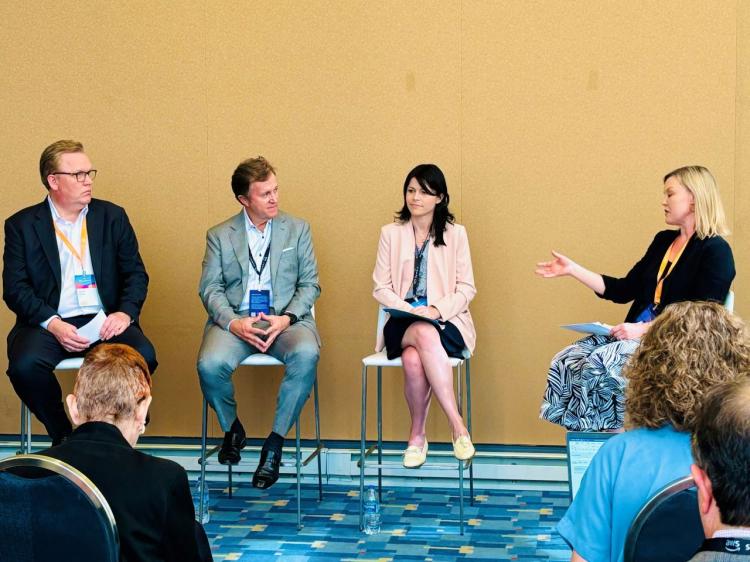By: Haley Fisackerly President and CEO, Entergy Mississippi

(l-r) AWS Vice President of Public Policy for the Americas Shannon Kellogg, Entergy Mississippi President and CEO Haley Fisackerly, ACORE Senior Vice President of Policy and Engagement, Lesley Hunter
Across the nation, electricity demand forecasts are increasing, driven by economic development and our society's ever-increasing dependency on technology. The growth opportunities we have before us in Mississippi rely on many key outcomes, but the one I'm most excited about is Entergy Mississippi's ability to meet our customers' needs. We're going to do that, while continuing our commitment to build a better future by balancing power reliability and affordability for our customers.
When we say, meet customers' needs,' we're not only talking about having generation to meet the load that will come with the growth. We're also talking about building clean energy, efficiently.
I recently had the pleasure of sitting on a panel at the Amazon Web Services Summit in Washington, D.C., and it was clear that having AWS as a customer will allow us to both explore new grid strengthening technologies and continue leading our industry peers in sustainability goals as this new energy era emerges.
As the world's largest corporate purchaser of renewable energy, Amazon places high emphasis on sustainability. Amazon recently met its goal to match all of the electricity consumed across its operations with 100% renewable energy in 2023, and the company remains committed to its Climate Pledge to become net-zero carbon by 2040.Comparatively, Entergy was the first U.S. utility to set a voluntary greenhouse gas emission goal in 2001. We're also striving to achieve 50% carbon-free energy capacity by 2030 and net-zero carbon emissions by 2050. With these aligned goals, we're quickly working on clean energy projects to support AWS and prepare for more growth from companies alike.
Why is this important? As I told the room in D.C., new clean energy technologies that have been sitting on the shelf are expected to be practical at the utility scale in the near future. Bringing on a customer like AWS is allowing us to move closer toward improving the energy grid with those innovative technologies for the benefit of all our customers, current and future. Yes, solar energy is clean, carbon-free generation and we're adding 650 megawatts of it to our portfolio to support AWS.
But combined cycle generation is a clean technology we're also focused on to support the grid and our customers; it's efficient and has the capability to convert to hydrogen and enable carbon capture and storage technology. Along with the clean energy provided by Grand Gulf Nuclear Station, we're looking at a more diverse energy generation portfolio - which will help us reduce future environmental and market risks. Together, our investments in clean energy don't just help the environment, they help our communities prosper. And, they help keep customers' bills lower than they otherwise would be in the future.
Intelligent infrastructure
While we work to unlock those new generation options, we're tapping into grid enhancing technologies that allow us to deliver power you can count on and be more resilient during increasingly extreme weather events. Artificial intelligence and predictive modeling is helping us identify and make equipment repairs before they're needed.
We're also using temperature-adjusted ratings in real-time, and collecting data through sensors and devices, to anticipate when ambient temperatures may impact the flow of power. Operators are using that data to reroute power to other existing circuits to minimize impact to our customers.
As we collect more data, AI is going to accelerate our understanding of how we can more efficiently deploy energy and unlock more renewables and opportunities. I boldly believe there will be a day when electric utilities are able to tell customers they will never lose power.
Changing the landscape
As I sat on that panel in D.C. beside AWS' Vice President of Public Policy for the Americas, Shannon Kellogg, and ACORE's Senior Vice President of Policy and Engagement, Lesley Hunter, we agreed that data centers are changing the energy landscape.
Is there enough land and electricity? That's the question driving decisions today about where data center companies will locate facilities or expand operations. With the help of supportive communities and regulators, we're optimally situated to provide that speed. Entergy Mississippi is a key economic development partner in recruiting new business to the state. That translates to jobs and investments right here in Mississippi communities.
We were at the table with AWS five years before the announcement of the company's historic planned $10 billion investment, and our confidence in the strength and durability of our pipeline is high. This will be a record year for the number of requests we've received for interconnection studies. That's important because it's our first indication that a customer is serious about locating to our service area.
One of the biggest and most stable markets for data center investment is the Gulf Region. We caught a big fish, but it's only the beginning. The transition to electrification and cleaner energy will not only reduce carbon emissions, but will also lead to onshoring of jobs, increased tax revenue, investment in educational programs, and a better quality of life in the communities we serve.









